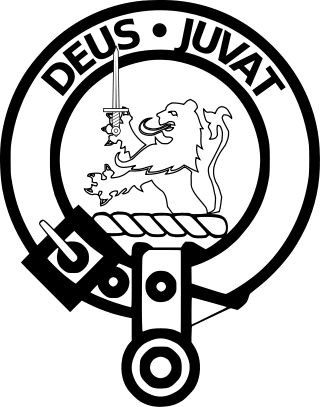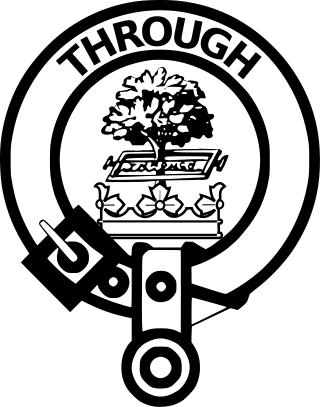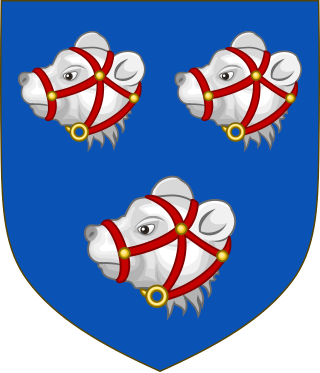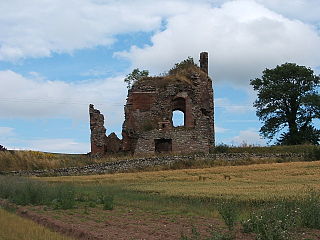
Clan Campbell is a Highland Scottish clan, historically one of the largest and most powerful of the Highland clans. The Clan Campbell lands are in Argyll and within their lands lies Ben Cruachan. The chief of the clan became Earl of Argyll and later Duke of Argyll.

Clan MacDuff or Clan Duff is a Lowland Scottish clan. The clan does not currently have a chief and is therefore considered an Armigerous clan, which is registered with the Lyon Court. The early chiefs of Clan MacDuff were the original Earls of Fife, although this title went to the Stewarts of Albany in the late fourteenth century. The title returned to the MacDuff chief when William Duff was made Earl Fife in 1759. His descendant Alexander Duff was made Duke of Fife in 1889.

Clan Scott is a Scottish clan and is recognised as such by the Lord Lyon King of Arms. Historically the clan was based in the Scottish Borders.

Clan Gordon is a Highland Scottish clan, historically one of the most powerful Scottish clans. The Gordon lands once spanned a large territory across the Highlands. Presently, Gordon is seated at Aboyne Castle, Aberdeenshire. The Chief of the clan is the Earl of Huntly, later the Marquess of Huntly.

Clan Sutherland also known as House of Sutherland is a Highland Scottish clan whose traditional territory is the shire of Sutherland in the far north of Scotland. The chief of the clan was also the powerful Earl of Sutherland, however in the early 16th century this title passed through marriage to a younger son of the chief of Clan Gordon. The current chief is Alistair Sutherland who holds the title Earl of Sutherland.

Clan Sinclair is a Highland Scottish clan which holds the lands of Caithness, the Orkney Islands, and the Lothians. The chiefs of the clan were the Barons of Roslin and later the Earls of Orkney and Earls of Caithness.

Clan Murray is a Highland Scottish clan. The chief of the Clan Murray holds the title of Duke of Atholl. Their ancestors were the Morays of Bothwell who established the family in Scotland in the 12th century. In the 16th century, descendants of the Morays of Bothwell, the Murrays of Tullibardine, secured the chiefship of the clan and were created Earls of Tullibardine in 1606. The first Earl of Tullibardine married the heiress to the Stewart earldom of Atholl and Atholl therefore became a Murray earldom in 1626. The Murray Earl of Atholl was created Marquess of Atholl in 1676 and in 1703 it became a dukedom. The marquess of Tullibardine title has continued as a subsidiary title, being bestowed on elder sons of the chief until they succeed him as Duke of Atholl.

Clan Carmichael is a Scottish clan and is also considered a sept of the Clan Douglas, Clan MacDougall, Stewart of Appin, and Stewart of Galloway.

Clan Crichton is a Lowland Scottish clan that historically ruled Dumfries.

The Clan Hamilton, or House of Hamilton, is a Scottish clan of the Scottish Lowlands.

Clan Home is a Scottish clan. It held immense power for much of the Middle Ages and dominated the eastern Scottish Borders. It produced no fewer than eight Wardens of the Eastern March – more than any other family.

Clan Mar is a Scottish clan of the Scottish Lowlands. It is also officially known as the Tribe of Mar. The chiefs of the Clan Mar were the original Earls of Mar, although this title later went via an heiress to the Douglases in the late fourteenth century, and then to the Stewarts before going to the Erskines. The current chief of Clan Mar is Margaret of Mar, Countess.

Clan Lockhart is an ancient family from the Scottish Lowlands.

Clan Maitland is a Lowland Scottish clan.

Clan Forbes is a Highland Scottish clan from Aberdeenshire, Scotland.

Torthorwald Castle is a large ruined rectangular tower at the centre of the village of Torthorwald just outside Dumfries in south west Scotland.

Clan Bissett is a Scottish clan. The clan is recognised by the Lord Lyon King of Arms but does not have a clan chief recognised by the Lord Lyon King of Arms, therefore the clan has no standing under Scots Law. Clan Bissett is considered an armigerous clan, meaning that it is considered to have had at one time a chief who possessed the chiefly arms; however, no one at present is in possession of such arms. The surname Bissett is also considered a sept of the Clan Fraser of Lovat.

Drumsagard Village is a new construction village in Cambuslang, South Lanarkshire. It is built around the site of Drumsagard Castle and immediately south of the site of Hallside Steelworks, also known as the Cambuslang Iron and Steel Works. One of the first facilities of their kind and eventually extending over an area of around 33 acres, the steelworks were established in 1873 and closed in 1979.
Strathblock Castle, Uphall, West Lothian, Scotland, was a motte-and-bailey castle. The castle was the caput of the barony of Strathbrock. The lands were given to Freskyn, a Flemish nobleman, by King David I of Scotland in the 12th century. The castle passed by marriage to the le Chen family. By 1435, the castle was in the hands of the Douglas family, and in 1524 the rector of Strathbrock Church lived there. The castle may have been a motte, with later stone buildings, and its remains were visible in the early 18th century. The area, to the south of Uphall's Main Street, is now built up.
Abercorn Castle was a 12th-century castle near Abercorn in West Lothian, Scotland.


















